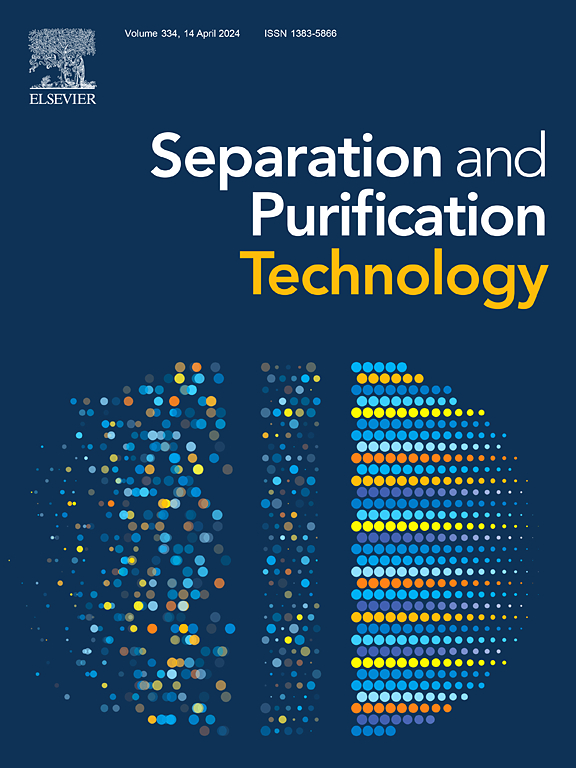N-defects and P-doping synergistically promote carbon nitride photocatalytic activation of peroxomonosulfate: Triggering the selective generation of 1O2 to degrade 4-Chlorophenol
IF 8.1
1区 工程技术
Q1 ENGINEERING, CHEMICAL
引用次数: 0
Abstract
Metal-based catalyst could be used for efficient peroxymonosulfate (PMS) activation, but inevitably suffered from metal ion leaching. Metal-free graphitic carbon nitride (g-C3N4) materials that can activate PMS are more conducive for practical water treatment. In this study, g-C3N4 with both N-defects and P-doping (CN-NP) was synthesized, which mainly produce singlet oxygen (1O2), and 97 % of 4-CP (4-Chlorophenol) was removed by CN-NP/PMS/Vis reaction system within 60 min. The active species was identified by quenching experiments and electron spin resonance (ESR) tests, and the origin of mainly active species was further verified by the concentration change of PMS during the reaction. It was verified by experiments and theoretical calculations that the introduction of N-defects led to the separation of photoinduced electron-hole pairs and improved photocatalytic activity. Notably, density functional theory (DFT) revealed that both N-defects and P-doping are electron-deficient sites, and P-doping acts as the main PMS adsorption site to promote the loss of electrons from PMS to generate 1O2. In addition, the catalysts developed in this research were anticipated to be applied in real wastewater treatment, contributing to further comprehend the mechanisms of element doping and defect modification in g-C3N4 activating PMS, and providing new insights for the design of PMS-activating catalysts.
N 缺陷和 P 掺杂协同促进了氮化碳对过硫酸单胞菌的光催化活化:触发选择性生成 1O2 以降解 4-氯苯酚
金属基催化剂可用于高效活化过一硫酸盐(PMS),但不可避免地会受到金属离子浸出的影响。能够活化 PMS 的无金属氮化石墨碳(g-C3N4)材料更有利于实用水处理。本研究合成了具有 N 缺陷和 P 掺杂的 g-C3N4(CN-NP),它主要产生单线态氧(1O2),CN-NP/PMS/Vis 反应体系在 60 分钟内可去除 97% 的 4-CP(4-氯苯酚)。通过淬灭实验和电子自旋共振(ESR)测试确定了活性物种,并通过反应过程中 PMS 的浓度变化进一步验证了主要活性物种的来源。实验和理论计算证实,N 缺陷的引入导致了光诱导电子-空穴对的分离,提高了光催化活性。值得注意的是,密度泛函理论(DFT)揭示了 N 缺陷和 P 掺杂都是缺电子位点,而 P 掺杂是 PMS 的主要吸附位点,可促进 PMS 失电子生成 1O2。此外,本研究开发的催化剂有望应用于实际废水处理,有助于进一步理解 g-C3N4 中元素掺杂和缺陷修饰激活 PMS 的机理,并为设计 PMS 激活催化剂提供新的见解。
本文章由计算机程序翻译,如有差异,请以英文原文为准。
求助全文
约1分钟内获得全文
求助全文
来源期刊

Separation and Purification Technology
工程技术-工程:化工
CiteScore
14.00
自引率
12.80%
发文量
2347
审稿时长
43 days
期刊介绍:
Separation and Purification Technology is a premier journal committed to sharing innovative methods for separation and purification in chemical and environmental engineering, encompassing both homogeneous solutions and heterogeneous mixtures. Our scope includes the separation and/or purification of liquids, vapors, and gases, as well as carbon capture and separation techniques. However, it's important to note that methods solely intended for analytical purposes are not within the scope of the journal. Additionally, disciplines such as soil science, polymer science, and metallurgy fall outside the purview of Separation and Purification Technology. Join us in advancing the field of separation and purification methods for sustainable solutions in chemical and environmental engineering.
 求助内容:
求助内容: 应助结果提醒方式:
应助结果提醒方式:


